Loading AI tools
Substances applied to the body to change appearance or fragrance From Wikipedia, the free encyclopedia
Cosmetics are composed of mixtures of chemical compounds derived from either natural sources or synthetically created ones.[1] Cosmetics have various purposes, including personal and skin care. They can also be used to conceal blemishes and enhance natural features (such as the eyebrows and eyelashes). Makeup can also add colour to a person's face, enhance a person's features or change the appearance of the face entirely to resemble a different person, creature, or object.[2]
This article needs additional citations for verification. (October 2020) |
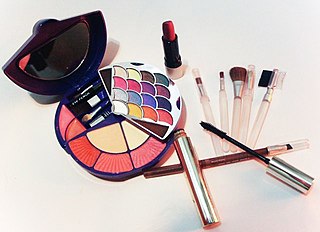


People have used cosmetics for thousands of years for skin care and appearance enhancement. Visible cosmetics for women and men have gone in and out of fashion over the centuries.
Some early forms of cosmetics used harmful ingredients such as lead that caused serious health problems and sometimes resulted in death. Modern commercial cosmetics are generally tested for safety but may contain controversial ingredients, such as per- and polyfluoroalkyl substances (PFAS), formaldehyde releasers, and ingredients that cause allergic reactions.
The European Union and regulatory agencies around the world have stringent regulations for cosmetics. In the United States, cosmetic products and ingredients do not require FDA approval. Some countries have banned using animals for cosmetic testing.
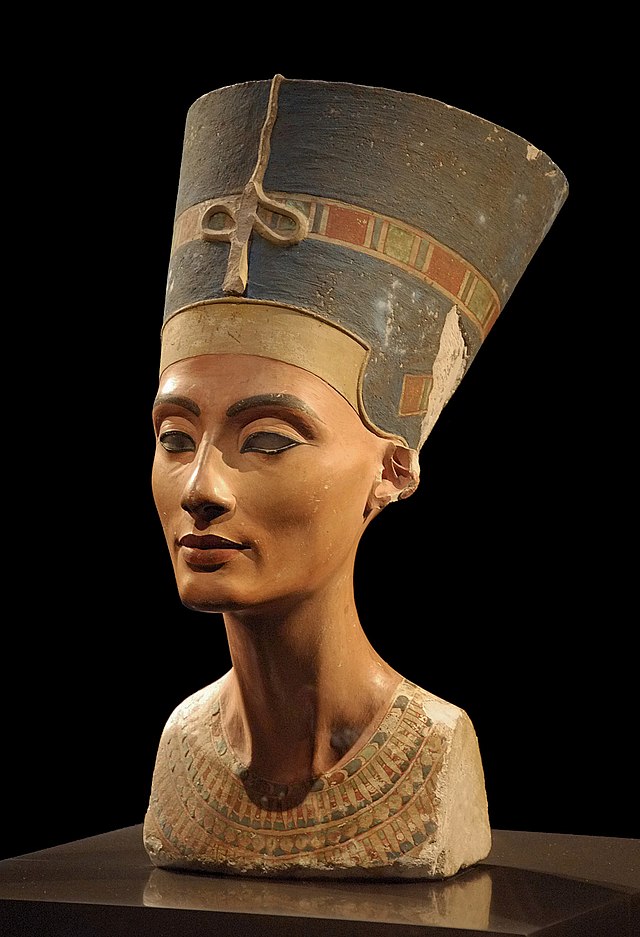

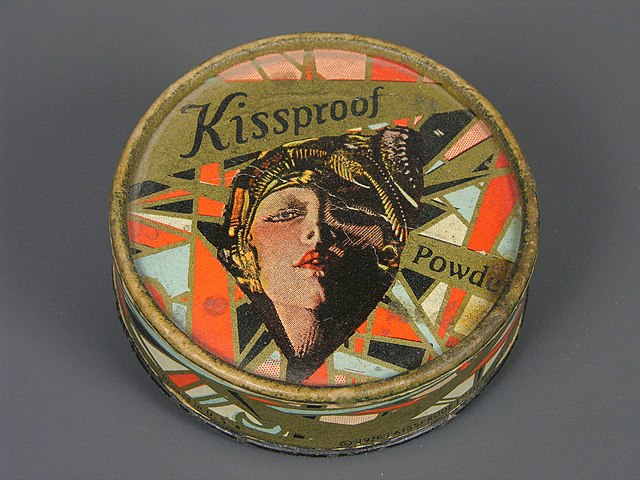
The word cosmetics is derived from the Greek κοσμητικὴ τέχνη (kosmetikē tekhnē), meaning "technique of dress and ornament," from κοσμητικός (kosmētikos), "skilled in ordering or arranging,"[3] and from κόσμος (kosmos), meaning "order" and "ornament.".[4]
The examples and perspective in this section may not represent a worldwide view of the subject. (August 2021) |
Though the legal definition of cosmetics in most countries is broader, in some Western countries,[which?] cosmetics are commonly taken to mean only makeup products, such as lipstick, mascara, eye shadow, foundation, blush, highlighter, bronzer, fake eyelashes, eyeliner, concealer, lip gloss, and several other product types.[clarification needed]
In the United States, the Food and Drug Administration (FDA), which regulates cosmetics,[5] defines cosmetics as products "intended to be applied to the human body for cleansing, beautifying, promoting attractiveness, or altering the appearance without affecting the body's structure or functions." This broad definition includes any material intended for use as an ingredient in a cosmetic product, with the FDA specifically excluding pure soap from this category.[6]
Cosmetics designed for skin care may be used to cleanse, exfoliate and protect the skin, as well as replenish it, using body lotions, cleansers, toners, serums, moisturizers, eye creams, retinol, and balms. Cosmetics designed for more general personal care, such as shampoo, soap, and body wash, can be used to clean the body.
Cosmetics designed to enhance one's appearance (makeup) can be used to conceal blemishes, enhance one's natural features, or add color to a person's face. In some cases, more extreme forms of makeup are used for performances, fashion shows, and people in costume and can change the appearance of the face entirely to resemble a different person, creature, or object. Techniques for changing appearance include contouring, which aims to give shape to an area of the face.
Cosmetics can also be designed to add fragrance to the body.
Products used for haircare, such as permanent waves, hair colors, and hairsprays, are classified as cosmetic products as well.[7]
Cosmetics have been in use for thousands of years, with ancient Egyptians and Sumerians using them. In Europe, the use of cosmetics continued into the Middle Ages—where the face was whitened and the cheeks rouged—[8] though attitudes towards cosmetics varied throughout time, with the use of cosmetics being openly frowned upon at many points in Western history.[9] Regardless of the changes in social attitudes towards cosmetics, many occasionally achieved ideals of appearance through cosmetics.
According to one source, early major developments in cosmetics include:[1]
Historically, the absence of regulation of the manufacture and use of cosmetics, as well as the absence of scientific knowledge regarding the effects of various compounds on the human body for much of this time period, led to a number of negative effects upon those who used cosmetics, including deformities, blindness, and, in some cases, death. Although harmless products were used, such as berries, and beetroot, many cosmetic products available at this time were still chemically dubious and even poisonous. Examples of the prevalent usage of harmful cosmetics include the use of ceruse (white lead) throughout a number of different cultures, such as during the Renaissance in the West, and blindness caused by the mascara Lash Lure during the early 20th century. During the 19th century, there were numerous incidents of lead poisoning due to the fashion for red and white lead makeup and powder, leading to swelling and inflammation of the eyes, weakened tooth enamel, and blackened skin, with heavy use known to lead to death.[10] Usage of white lead was not confined only to the West, with the white Japanese face makeup known as oshiroi also produced using white lead. In the second part of the 19th century, scientific advances in the production of makeup lead to the creation of makeup free of hazardous substances such as lead.[citation needed]
Throughout the late 19th and early 20th centuries, changes in the prevailing attitudes towards cosmetics led to a wider expansion of the cosmetics industry. In 1882, English actress and socialite Lillie Langtry became the poster girl for Pears of London, making her the first celebrity to endorse a commercial product.[11] She allowed her name to be used on face powders and skin products.[12] During the 1910s, the market in the US was developed by figures such as Elizabeth Arden, Helena Rubinstein, and Max Factor. These firms were joined by Revlon just before World War II and Estée Lauder just after. By the middle of the 20th century, cosmetics were in widespread use by women in nearly all industrial societies around the world, with the cosmetics industry becoming a multibillion-dollar enterprise by the beginning of the 21st century.[13] The wider acceptance of the use of cosmetics led some to see makeup as a tool used in the oppression and subjection of women to unfair societal standards. In 1968, at the feminist Miss America protest, protesters symbolically threw a number of feminine products into a "Freedom Trash Can",[14] with cosmetics among the items the protesters called "instruments of female torture"[15] and accoutrements of what they perceived to be enforced femininity.
As of 2016[update], the world's largest cosmetics company is L'Oréal, founded by Eugène Schueller in 1909 as the French Harmless Hair Colouring Company (now owned by Liliane Bettencourt 26% and Nestlé 28%; the remaining 46% is traded publicly).
Although modern makeup has been traditionally used mainly by women, men also use makeup to enhance their own facial features or cover blemishes and dark circles. The negative stigma of men wearing makeup in countries such as the United States has weakened over the years, with the number of men using makeup increasing in the 21st century.[16] Cosmetics brands have increasingly targeted men in the sale of cosmetics, with some products targeted specifically at men.[17][18]
Lead has been used as a makeup product since the 18th century. It is said to be lethal to women who apply it daily to achieve a pale complexion representing nobility, as tanner skin represents the working class. Lead can be detrimental to people's health and cause death if mixed with vinegar which it allows lead to be absorbed through the skin.[19]

Though there are a large number of different cosmetics used for a variety of different purposes, all cosmetics are typically intended to be applied externally. These products can be applied to the face (on the skin, lips, eyebrows, and eyes), to the body (on the skin, particularly the hands and nails), and to the hair. These products may be intended for use as skincare, personal care, or to alter the appearance, with the subset of cosmetics known as makeup primarily referring to products containing colour pigments intended for the purpose of altering the wearer's appearance; some manufacturers will distinguish only between "decorative" cosmetics intended to alter the appearance and "care" cosmetics designed for skincare and personal care.
Most cosmetics are also distinguished by the area of the body intended for application, with cosmetics designed to be used on the face and eye area usually applied with a brush, a makeup sponge, or the fingertips. Cosmetics can also be described by the physical composition of the product. Cosmetics can be liquid or cream emulsions, powders (pressed or loose), dispersions, or anhydrous creams or sticks.
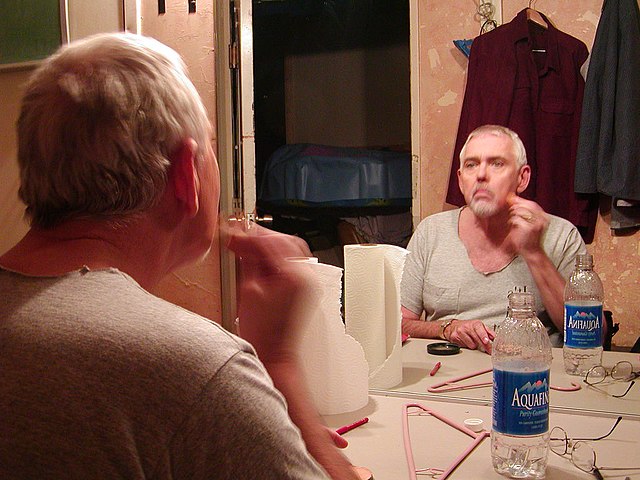
Cleansing is a standard step in skin care routines. Skin cleansing includes some or all of these steps or cosmetics:
Hair care is a category of cosmetics devoted to products which are used to improve the appearance of hair.[28]
Perfumes or fragrances, are liquids that can be sprayed or applied to produce a long-lasting smell.[30] They are created by mixing different compounds together. There are different groups of perfumes which are categorised according to their concentration.[30]
The difference between Eau de parfum and Eau de toilette is more about the perfume oil concentration. Eau de parfum has a higher concentration of perfume than Eau de toilette.

Various tools are used to apply cosmetics.
In addition to brushes, a makeup sponge is a popular applicator. Makeup sponges can be used to apply foundation, blend concealer, and apply powder or highlighter.
Loofahs, microfiber cloths, natural sponges, or brushes may be used to exfoliate skin simply by rubbing them over the face in a circular motion. Gels, creams, or lotions may contain an acid to encourage dead skin cells to loosen, and an abrasive such as microbeads, sea salt and sugar, ground nut shells, rice bran, or ground apricot kernels to scrub the dead cells off the skin. Salt and sugar scrubs tend to be the harshest, while scrubs containing beads or rice bran are typically very gentle.

A variety of organic compounds and inorganic compounds comprise typical cosmetics. Typical organic compounds are modified natural oils and fats as well as a variety of petrochemically derived agents. Inorganic compounds are processed minerals such as iron oxides, talc, and zinc oxide. The oxides of zinc and iron are classified as pigments, i.e., colorants that have no solubility in solvents. Cosmetic companies have become more transparent in the ingredients of their products because consumers are interested in the formula of their products.[32]
Handmade and certified organic products are becoming more mainstream due to consumer concerns that certain chemicals in some skincare products may be harmful if absorbed through the skin. The FDA, which regulates the US cosmetic industry, says "FDA has not defined the term “natural” and has not established a regulatory definition for this term in cosmetic labeling."[33] It goes on to warn consumers, "choosing ingredients from sources you consider “organic” or “natural” is no guarantee that they are safe."
The term "mineral makeup" applies to a category of face makeup, including foundation, eye shadow, blush, and bronzer, made with loose, dry mineral powders. These powders are often mixed with oil-water emulsions. Lipsticks, liquid foundations, and other liquid cosmetics, as well as compressed makeups such as eye shadow and blush in compacts, are often called mineral makeup if they have the same primary ingredients as dry mineral makeups. Liquid makeups must contain preservatives, and compressed makeups must contain binders, which dry mineral makeups do not. Mineral makeup usually does not contain synthetic fragrances, preservatives, parabens, mineral oil, or chemical dyes. For this reason, dermatologists may consider mineral makeup to be gentler on the skin than makeup that contains those ingredients.[34] Some minerals are nacreous or pearlescent, giving the skin a shining or sparking appearance. One example is bismuth oxychloride.[1] There are various mineral-based makeup brands, including: Bare Minerals, Tarte, Bobbi Brown, and Stila.
The term cosmetic packaging is used for primary packaging and secondary packaging of cosmetic products.[citation needed]
Primary packaging, also called cosmetic containers, houses the cosmetic product. It is in direct contact with the cosmetic product. Secondary packaging is the outer wrapping of one or several cosmetic container(s). An important difference between primary and secondary packaging is that any information that is necessary to clarify the safety of the product must appear on the primary package. Otherwise, much of the required information can appear on just the secondary packaging.[35]
Cosmetic packaging is standardized by ISO 22715, set by the International Organization for Standardization[36] and regulated by national or regional regulations such as those issued by the EU or the FDA. Marketers and manufacturers of cosmetic products must be compliant to these regulations to be able to market their cosmetic products in the corresponding areas of jurisdiction.[37]
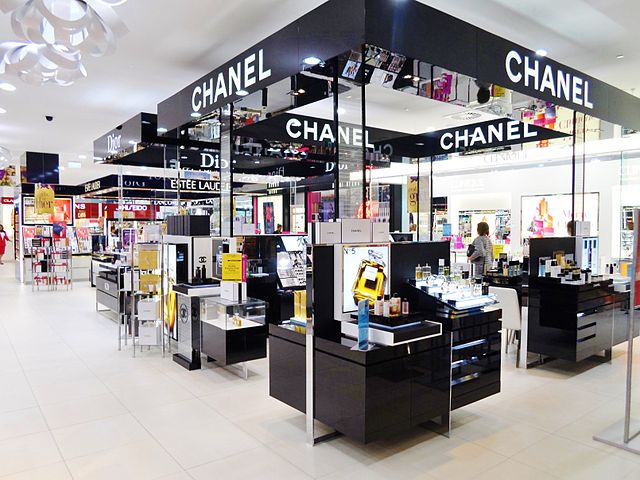
The manufacture of cosmetics is dominated by a small number of multinational corporations that originated in the early 20th century, but the distribution and sales of cosmetics are spread among a wide range of businesses. The world's largest cosmetic companies are L'Oréal, Procter & Gamble, Unilever, Shiseido, and Estée Lauder.[38] In 2005, the market volume of the cosmetics industry in the US, Europe, and Japan was about EUR 70 Billion/a year.[1] In Germany, the cosmetic industry generated €12.6 billion of retail sales in 2008,[39] which makes the German cosmetic industry the third largest in the world, after Japan and the United States. German exports of cosmetics reached €5.8 billion in 2008, whereas imports of cosmetics totaled €3 billion.[39]
The worldwide cosmetics and perfume industry currently generates an estimated annual turnover of US$170 billion (according to Eurostaf, May 2007). Europe is the leading market, representing approximately €63 billion, while sales in France reached €6.5 billion in 2006, according to FIPAR (Fédération des Industries de la Parfumerie – the French federation for the perfume industry).[40][unreliable source?] France is another country in which the cosmetic industry plays an important role, both nationally and internationally. According to data from 2008, the cosmetic industry has grown constantly in France for 40 consecutive years. In 2006, this industrial sector reached a record level of €6.5 billion. Famous cosmetic brands produced in France include Vichy, Yves Saint Laurent, Yves Rocher, and many others.
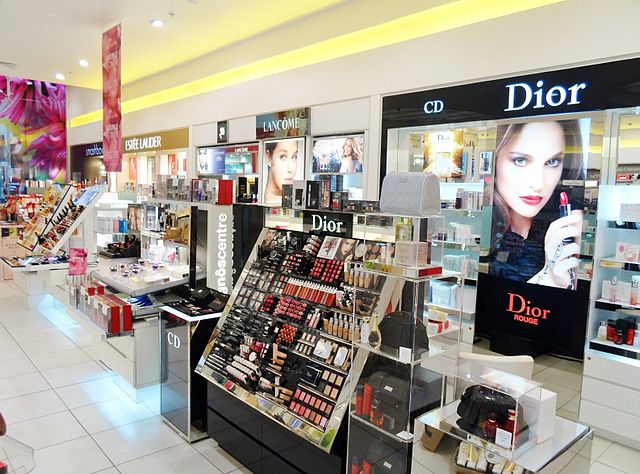
The Italian cosmetic industry is also an important player in the European cosmetic market. Although not as large as in other European countries, the cosmetic industry in Italy was estimated to reach €9 billion in 2007.[citation needed] The Italian cosmetic industry is dominated by hair and body products and not makeup as in many other European countries. In Italy, hair and body products make up approximately 30% of the cosmetic market. Makeup and facial care are the most common cosmetic products exported to the United States.
According to Euromonitor International, the market for cosmetics in China is expected to be $7.4 billion in 2021 up from $4.3 billion in 2016. The increase is due to social media and the changing attitudes of people in the 18-to-30-year age bracket.[41]
Due to the popularity of cosmetics, especially fragrances, many designers who are not necessarily involved in the cosmetic industry came up with perfumes bearing their names. Moreover, some actors and singers (such as Celine Dion) have their own perfume line. Designer perfumes are, like any other designer products, the most expensive in the industry as the consumer pays for the product and the brand. Famous Italian fragrances are produced by Giorgio Armani, Dolce & Gabbana, and others.
Procter & Gamble, which sells CoverGirl and Dolce & Gabbana makeup, funded a study[42] concluding that makeup makes women seem more competent.[43] Due to the source of funding, the quality of this Boston University study is questioned.
Cosmetics products may be retailed in beauty stores, department stores and hypermarkets, drugstores, variety stores, grocery stores, beauty supply stores, and many other formats, and in similar types of online stores or the online presence of these types of physical stores.
Cosmetic companies have changed their traditional methods of marketing by using social media influencers and brand ambassadors to market their products.[32]
During the 20th century, the popularity of cosmetics increased rapidly.[44] Cosmetics are used by girls at increasingly young ages, especially in the United States. Because of the fast-decreasing age of makeup users, many companies, from drugstore brands like Rimmel to higher-end products like Estee Lauder, cater to this expanding market by introducing flavored lipsticks and glosses, cosmetics packaged in glittery and sparkly packaging, and marketing and advertising using young models.[45] The social consequences of younger and younger cosmetics use have had much attention in the media over the last few years.
Criticism of cosmetics has come from a wide variety of sources including some feminists,[46] religious groups, animal rights activists, authors, and public interest groups. It has also faced criticism from men, some of whom describe it as a form of deception or fakeup.[47]
The new generation has been more accepting of males wearing makeup, and having a "soft pretty boy" look in South Korea has become more widespread in recent years, particularly among younger generations. This trend is known as "K-beauty," and it has been popularized by K-pop idols, actors, and social media influencers. Many of these idols have become beauty icons and have allowed many men to access beauty products and to feel comfortable using them. While there may still be some societal pressure to conform to traditional gender norms, there is also a growing acceptance of individual expression and breaking free from traditional gender roles.[48][49]
In 2023 and 2024, many people posting on social media have reported seeing girls, ranging from 10 to 12 in age in popular cosmetic stores, such as the likes of Boots and Sephora.[50] This is most commonly reported in western countries, specifically America, Australia and the United Kingdom. This has garnered attention because it bring awareness to the growing need for make-up for younger girls and women, many criticise this claiming it's connected to western beauty standards which in recent years have become an increasingly controversial topic in many medias revolving around politics and womans rights.[51] It's also a hot topic in medical spaces such as dermatology, due to the increase of young girls using anti-aging cream, despite only being around 11 years old. [52]

In the United States, "Under the law, cosmetic products and ingredients do not need FDA premarket approval."[55] The EU and other regulatory agencies around the world have more stringent regulations.[56] The FDA does not have to approve or review cosmetics, or what goes in them, before they are sold to consumers. The FDA only regulates some colors that can be used in the cosmetics and hair dyes. The cosmetic companies do not have to report any injuries from the products; they also only have voluntary recalls of products.[5]
There has been a marketing trend towards the sale of cosmetics lacking controversial ingredients, especially those derived from petroleum, sodium lauryl sulfate (SLS), and parabens.[57] Per- and polyfluoroalkyl substances (PFAS) are a class of about 9,000 synthetic organofluorine compounds that have multiple highly toxic fluorine atoms attached to an alkyl chain. PFAS are used by major cosmetics industry companies in a wide range of cosmetics, including such products as lipstick, eye liner, mascara, foundation, concealer, lip balm, blush, nail polish. A 2021 study tested 231 personal care products and found organic fluorine, a hallmark of PFAS, in more than half of the samples. Substantial levels of fluorine were identified in tested brands of products as follows: 82% of the brands of waterproof mascara, 63% of the brands of foundations, and 62% of liquid lipstick. PFAS compounds are readily absorbed through human skin and through tear ducts, and such products on lips are often unwittingly ingested. Manufacturers often fail to label their products as containing PFAS, which makes it difficult for cosmetics consumers to avoid products containing PFAS.[58]
Formaldehyde is no longer used in cosmetics but has been replaced by formaldehyde releasers. Formaldehyde is dangerous to human health, especially when inhaled.[59][60][61] In 2011, the US National Toxicology Program described formaldehyde as "known to be a human carcinogen".[62][63][64]
The danger of formaldehyde is a major reason for the development of formaldehyde releasers which release formaldehyde slowly at lower levels.[65]
Numerous reports have raised concern over the safety of a few surfactants, including 2-butoxyethanol. In some individuals, SLS may cause a number of skin problems, including dermatitis. Additionally, some individuals have had an emergence of vitiligo after using cosmetics containing the ingredient rhododendrol.[66][67][68][69][70][71]
Parabens can cause skin irritation and contact dermatitis in individuals with paraben allergies, a small percentage of the general population.[72] Animal experiments have shown that parabens have a weak estrogenic activity, acting as xenoestrogens.[73]

Perfumes are widely used in consumer products. Studies concluded from patch testing show fragrances contain some ingredients which may cause allergic reactions.[74]
Balsam of Peru was the main recommended marker for perfume allergy before 1977, which is still advised. The presence of Balsam of Peru in a cosmetic will be denoted by the INCI term Myroxylon pereirae.[75][76] In some instances, Balsam of Peru is listed on the ingredient label of a product by one of its various names, but it may not be required to be listed by its name by mandatory labeling conventions (in fragrances, for example, it may simply be covered by an ingredient listing of "fragrance").[76][77][78][79]
Some cosmetics companies have made pseudo-scientific claims about their products which are misleading or unsupported by scientific evidence.[80][81]
As of 2019, an estimated 50–100 million animals are tested each year in locations such as the United States and China.[82] Such tests have involved general toxicity, eye and skin irritants, phototoxicity (toxicity triggered by ultraviolet light), and mutagenicity.[83][84] Due to ethical concerns around animal testing, some nations have legislated against animal testing for cosmetics. An updated list can be found on the Humane Societies website.[85] According to the Humane Society of the United States, there are nearly 50 non-animal tests that have been validated for use, and are potentially more efficacious.[86] In the United States, mice, rats, rabbits, and cats are the most used animals for testing.[87] In 2018, California banned the sale of animal-tested cosmetics.[88]
Cosmetics testing is banned in the Netherlands, India, Norway, Israel, New Zealand, Belgium, and the UK. In 2002, the European Union agreed to phase in a near-total ban on the sale of animal-tested cosmetics throughout the EU from 2009 and to ban all cosmetics-related animal testing.[89] In December 2009, the European Parliament and Council passed EC Regulation 1223/2009 on cosmetics, a bill to regulate the cosmetic industry in the EU.[90] EC Regulation 1223/2009 took effect on July 11, 2013.[90] In March 2013, the EU banned the import and sale of cosmetics containing ingredients tested on animals.[91] China required animal testing on cosmetic products until 2014, when they waived animal testing requirements for domestically produced products.[92] In 2019, China approved nine non-animal testing methods, and in 2020 laws making animal testing compulsory were lifted.[93]
In June 2017, legislation was proposed in Australia to end animal testing in the cosmetics industry.[94] In March 2019, the Australian Senate passed a bill that banned the use of data from animal testing in the cosmetic industry since July 1, 2020.[95]
In the European Union, the manufacture, labelling, and supply of cosmetics and personal care products are regulated by Regulation EC 1223/2009.[90] It applies to all the countries of the EU as well as Iceland, Norway, and Switzerland. This regulation applies to single-person companies making or importing just one product as well as to large multinationals. Manufacturers and importers of cosmetic products must comply with the applicable regulations in order to sell their products in the EU. In this industry, it is common fall back on a suitably qualified person, such as an independent third party inspection and testing company, to verify the cosmetics' compliance with the requirements of applicable cosmetic regulations and other relevant legislation, including REACH, GMP, hazardous substances, etc.[96][97]
In the European Union, the circulation of cosmetic products and their safety have been the subject of legislation since 1976. One of the newest improvements to the regulation concerning the cosmetic industry is the ban on animal testing. Testing cosmetic products on animals has been illegal in the European Union since September 2004, and testing the separate ingredients of such products on animals is also prohibited by law, since March 2009 for some endpoints and full since 2013.[98]
Cosmetic regulations in Europe are often updated to follow the trends of innovations and new technologies while ensuring product safety. For instance, all annexes of Regulation 1223/2009 were aimed at addressing potential risks to human health. Under the EU cosmetic regulation, manufacturers, retailers, and importers of cosmetics in Europe will be designated as "responsible persons.".[90] This new status implies that the responsible person has the legal liability to ensure that the cosmetics and brands they manufacture or sell comply with the current cosmetic regulations and norms. The responsible person is also responsible for the documents contained in the Product Information File (PIF), a list of product information including data such as Cosmetic Product Safety Report, product description, GMP statement, or product function.
In 1938, the U.S. passed the Food, Drug, and Cosmetic Act authorizing the Food and Drug Administration (FDA) to oversee safety via legislation in the cosmetic industry and its aspects in the United States.[99][100] The FDA joined with 13 other federal agencies in forming the Interagency Coordinating Committee on the Validation of Alternative Methods (ICCVAM) in 1997, which is an attempt to ban animal testing and find other methods to test cosmetic products.[101]
The current law on cosmetics in the U.S. does not require cosmetic products and ingredients to have FDA approval before going on the market, except from color additives.[102] The Cosmetic Safety Enhancement Act was introduced in December 2019 by Representative Frank Pallone.[103]
ANVISA (Agência Nacional de Vigilância Sanitária, Brazilian Health Surveillance Agency) is the regulatory body responsible for cosmetic legislation and directives in the country. The rules apply to manufacturers, importers, and retailers of cosmetics in Brazil, and most of them have been harmonized so they can apply to the entire Mercosur.
The current legislation restricts the use of certain substances, such as pyrogallol, formaldehyde, or paraformaldehyde, and bans the use of others, such as lead acetate in cosmetic products. All restricted and forbidden substances and products are listed in the regulation RDC 16/11 and RDC 162, 09/11/01.
More recently, a new cosmetic Technical Regulation (RDC 15/2013) was set up to establish a list of authorized and restricted substances for cosmetic use, used in products such as hair dyes, nail hardeners, or used as product preservatives.
Most Brazilian regulations are optimized, harmonized, or adapted in order to be applicable and extended to the entire Mercosur economic zone.
The International Organization for Standardization (ISO) published new guidelines on the safe manufacturing of cosmetic products under a Good Manufacturing Practices (GMP) regime. Regulators in several countries and regions have adopted this standard, ISO 22716:2007, effectively replacing existing guidance and standards. ISO 22716 provides a comprehensive approach for a quality management system for those engaged in the manufacturing, packaging, testing, storage, and transportation of cosmetic end products. The standard deals with all aspects of the supply chain, from the early delivery of raw materials and components until the shipment of the final product to the consumer.
The standard is based on other quality management systems, ensuring smooth integration with such systems as ISO 9001 or the British Retail Consortium (BRC) standard for consumer products. Therefore, it combines the benefits of GMP, linking cosmetic product safety with overall business improvement tools that enable organisations to meet global consumer demand for cosmetic product safety certification.[104]
In July 2012, since microbial contamination is one of the greatest concerns regarding the quality of cosmetic products, the ISO introduced a new standard for evaluating the antimicrobial protection of a cosmetic product by preservation efficacy testing and microbiological risk assessment.
Seamless Wikipedia browsing. On steroids.
Every time you click a link to Wikipedia, Wiktionary or Wikiquote in your browser's search results, it will show the modern Wikiwand interface.
Wikiwand extension is a five stars, simple, with minimum permission required to keep your browsing private, safe and transparent.